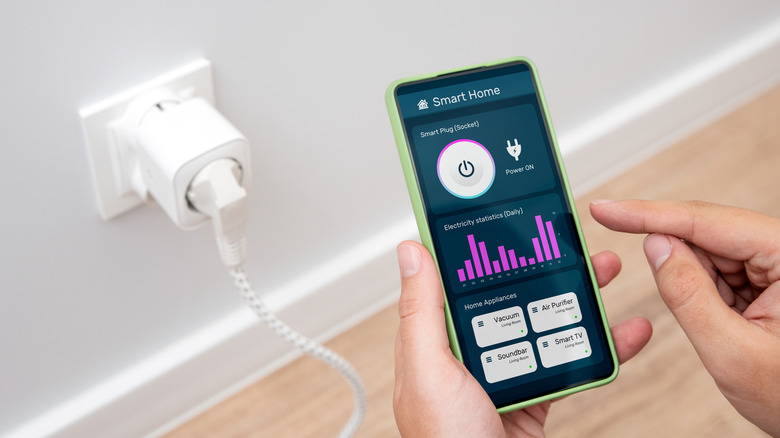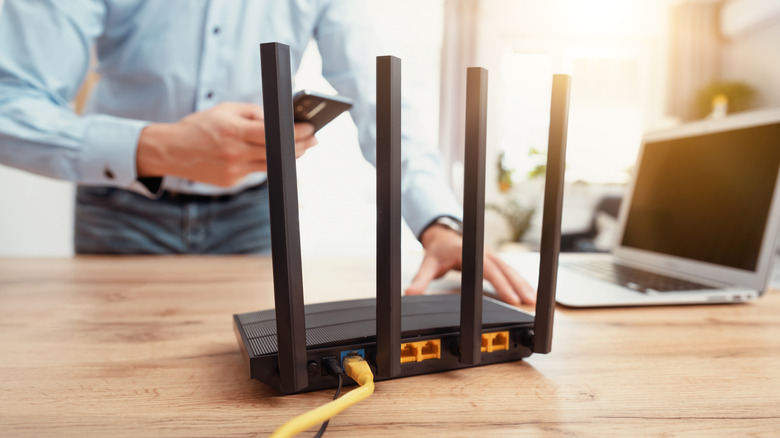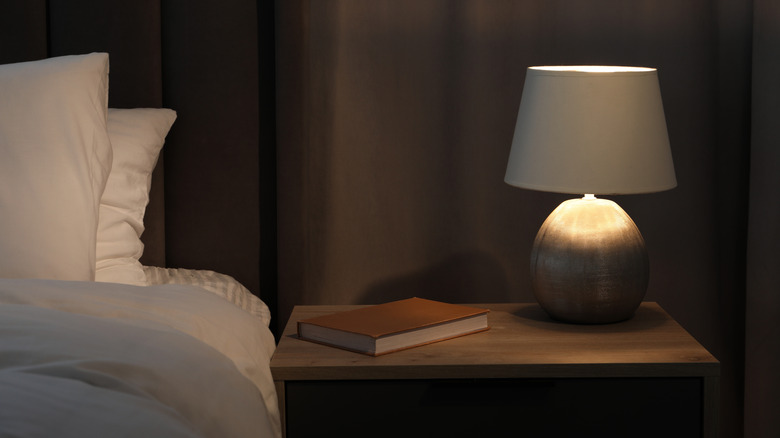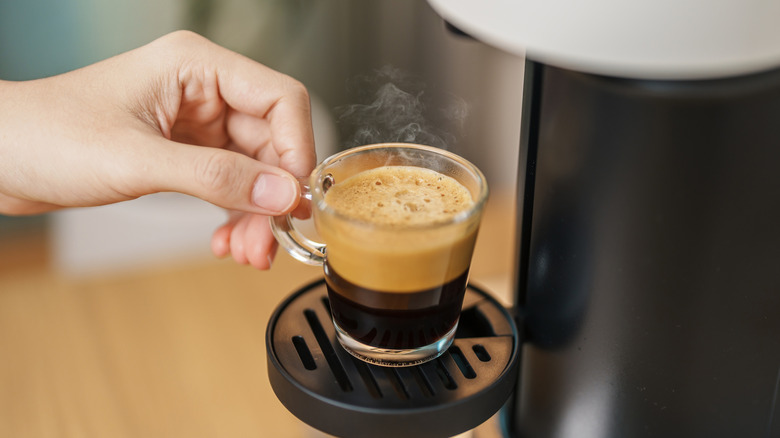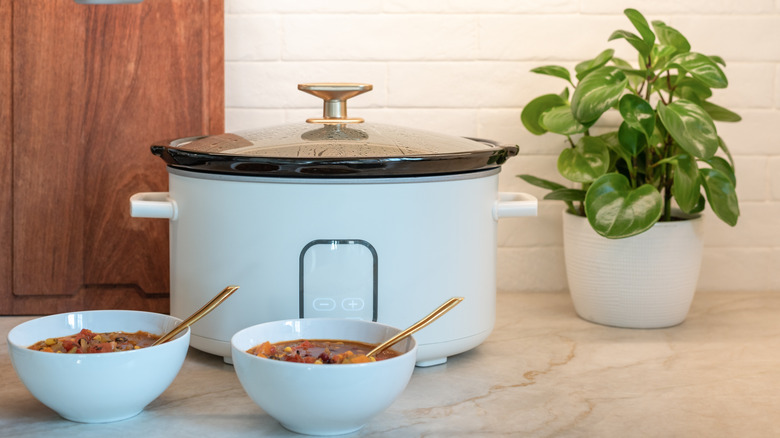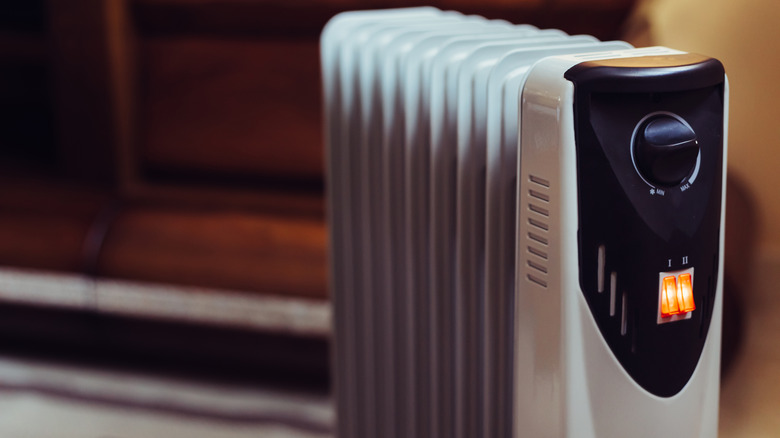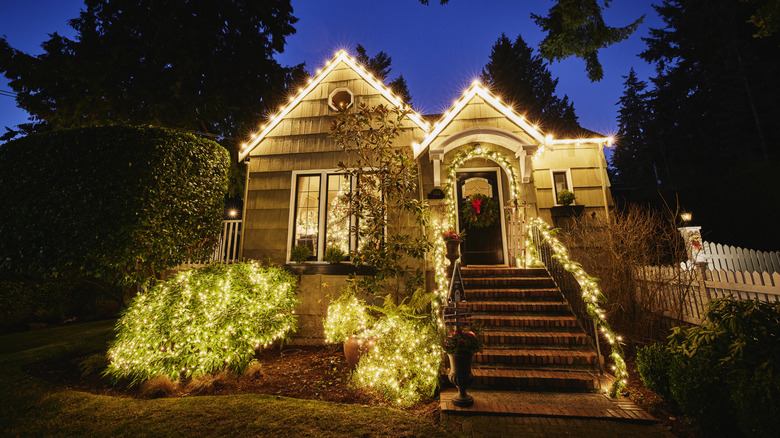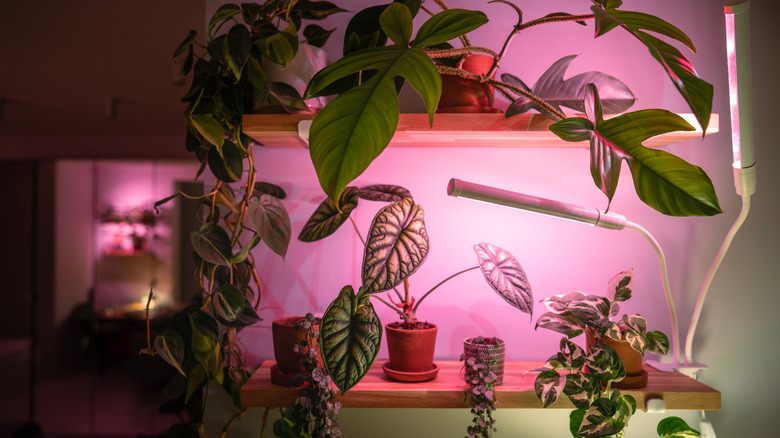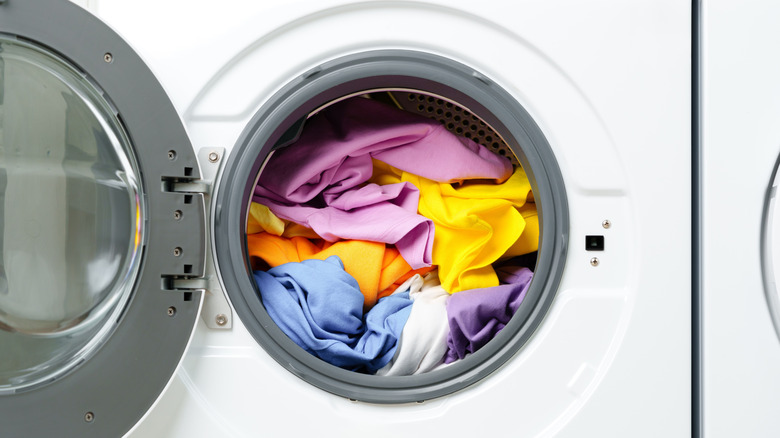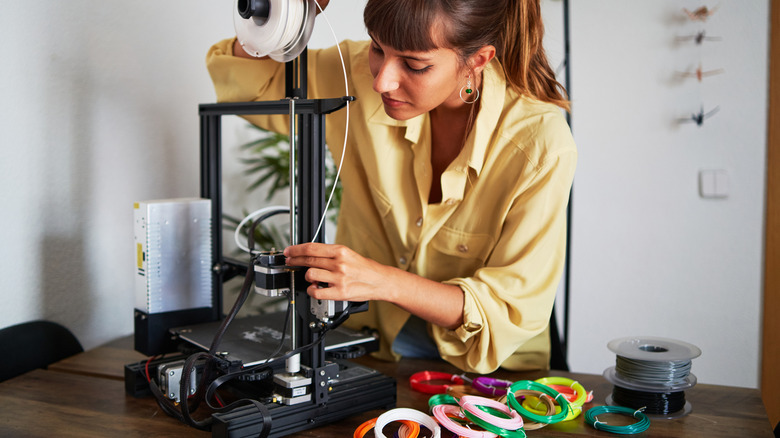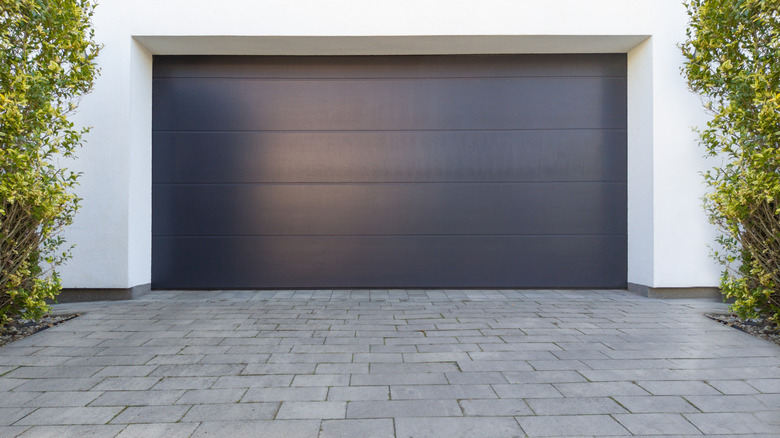10 Dumb Home Devices And Appliances You Can Upgrade With A Smart Plug
There are a growing number of smart appliances and gadgets on the market that can upgrade your at-home setup. If you want, you can find everything from the commonplace, like smart light bulbs and thermostats, to more obscure devices like smart pet feeders and gaming consoles. The biggest barriers to entry are cost and the fact that your "dumb" appliances might still work just fine. Fortunately, you can get some of the same smart functionality by adding a smart plug to your existing devices.
The simplest smart plugs work as a remote on and off switch, while more advanced versions also measure and report the energy consumption of whatever's plugged into them. With a smart plug, you can turn your devices on and off remotely using an app or with voice commands through a smart home hub. Plug the smart plug into your wall outlet, then plug your devices into the smart plug. You can find entry-level smart plugs for about $20, making them an affordable smart home entry point.
It should be noted that for our purposes, the word "dumb" is used broadly. Some of the items on our list already connect to the internet and may have their own "smart" functions built in. However, each of these devices can be improved upon through the addition of a smart plug. Put simply, some of these devices may be smart, but they could be smarter.
Wi-Fi router
Often, the simplest and most reliable way to fix just about any tech problem you encounter is to turn a machine off, wait a little while, and turn it back on again. It's a cliche, but it's a cliche for a reason.
Many devices operate continuously for weeks or months at a time without a break. Over time, they can experience problems with firmware, operating systems, and more. Turning it off and on again, also known as a power cycle or hard reset, can clear those problems, allowing your gadgets to operate correctly again. In complex systems, the process of power cycling can be complicated and have serious consequences if done improperly. At home, it's usually as simple as pulling the plug or pressing the power button, waiting 30 seconds, and then powering back up.
Routers are one of those devices that operate continuously for long periods of time. If your internet connection gets spotty, a router reset is step number one. That's where a smart plug comes in. Often, routers are located in inconvenient places, tucked into corners or nestled under desks. Using a smart plug means you can cut the power and restart it remotely without having to break your back.
Bedside lamp
The bedside lamp is one of the simplest and most dependable pieces of technology in our lives. Outside of advancements in light bulb and LED technologies, they haven't changed all that much in decades. Descended from candles and gas lamps of old, bedside lamps provide a little bit of light when you're settling down for bed or shaking off the fog of sleep in the morning.
Of course, if you need some light in the middle of the night, it means reaching through the dark to turn on the lamp, potentially knocking over your glass of water in the process. With a smart plug, you can avoid this dangerous midnight gamble and turn on your lamp remotely with your phone or with voice commands.
Connecting your bedside lamp (or any other light) to a smart plug transforms ordinary lights into smart lights. In addition to turning the lights on and off remotely, you can also schedule light and dark times through your smart plug's companion app. You'll know it's time for bed when the light turns off, and you'll wake up to artificial sunshine when it turns back on automatically in the morning.
Coffee machine
For many people, mornings are synonymous with the smell of freshly brewed coffee. A stereotypical morning routine involves stumbling into the kitchen, filling the pot with water and the filter full of coffee grounds, then waiting patiently for that first hot, steaming cup. With a smart plug, you can get the coffee brewing before you wipe the sand out of your eyes.
Funnily enough, smart plugs work better with simpler and more affordable coffee machines than with more complicated high-end machines. Complex coffee machines often use touch-based buttons and can't be activated simply by providing electricity. By contrast, simpler machines often have physical toggle switches with an on and off position, making them perfect for pairing with a smart plug.
Connect your machine to the plug and turn the power off. Then fill your coffee machine with water and a fresh filter filled with coffee grounds, and set the power switch to the on position. Schedule the smart plug to turn on a few minutes before your alarm goes off, and you'll wake up to freshly brewed coffee, courtesy of a smart plug and a little pre-planning. Just remember to refill the machine each night or turn the physical switch to the off position to avoid any undesired kitchen accidents.
Slow cooker
You've had a long day at work, you've picked up the kids, and finished running errands. Now, you're finally home and you still have to cook dinner. Our increasingly busy lives are a big part of the reason so many of us grab takeout or order delivery more often than before. Slow cookers meet you in the middle, cooking your food slowly over the course of several hours and greeting you with a warm home-cooked meal when you get home.
Smart slow cookers do exist, allowing you to control the cook temperature, see how much cook time is left, and turn the machine on or off from a distance, but that's not the norm. Most slow cookers make dinner time more convenient, but they have some limitations. In most cases, you have to turn on the slow cooker and select the cook temperature before you leave home. Without any built-in timer, your only option is to leave them on for the entire time you're away from home.
Adding a smart plug to your kitchen gives you a little more control. Set your slow cooker to the desired cook temperature and fill it with your chosen ingredients. Then turn the cooker on at the appropriate time so your food is perfectly cooked when you walk back through the door.
Climate control devices
The whole point of being inside your home is that it's comfortable and protects you from the climate extremes of the outside world. The walls keep the weather out, but it's a combination of insulation and climate control devices like heaters and coolers that keep you nice and comfortable inside your home all year round.
During the peak of summer, you might keep your air conditioner running around the clock so you don't have to think about it. But as the seasons change, you might find yourself turning heaters and coolers on and off frequently, trying to strike that perfect balance between too hot and too cold. Alternatively, you might want to save energy by turning off climate controls when you're not home.
A smart plug connected to your air conditioner, space heater, or room fans gives you remote control of your home climate. You can turn on your fans and set them to turn off in the middle of the night when the temperature drops. You can set your heater or air conditioner to turn on half an hour before you get home to keep yourself comfortable while saving energy. And if you have other smart tech in your home, you can set up routines so that your devices turn on and off when the temperature gets above or below a set threshold. You can even cut the power to a space heater if you forgot to turn it off before you left the house.
Outdoor lights
Outdoor electrical outlets are convenient for running electric lawnmowers and other landscaping equipment or for powering lights, speakers, and other appliances outside. People use them for everything from year-round porch lights to seasonal holiday lighting, all of which can benefit from the addition of a smart plug.
Typically, you want outdoor lights to be off during the day and on at night when everyone can enjoy and benefit from them. Unfortunately, outdoor lights rarely have a control switch or any convenient way of controlling them. Unless your lights have a switch built in, your only method of turning them off is to unplug them.
A smart plug solves that problem, allowing you to turn lights on and off remotely or schedule them to turn on and off at specific times. There are even reinforced outdoor smart plugs engineered to deal with the harsher conditions of an outdoor environment. While you're already outside, pick up a few extra smart plugs to control your sprinkler timers or inflatable holiday decorations.
Plant lights
Plants add a pop of color and good vibes to any space, but they need a reliable source of water and light if they're going to survive indoors. The basic ingredients of plant food come from the soil and air around them, but they need energy from light to power photosynthesis. With some exceptions (notably carnivorous plants), plants use sunlight, water, and carbon dioxide from the air to manufacture glucose in their cells. They use sunlight to break down carbon dioxide and water, producing sugar and oxygen in the process.
If your indoor plants aren't getting enough natural light, you can supplement their supply with artificial lighting. Plant lights, otherwise known as grow lights, produce light sufficient to support photosynthesis. Unlike conventional light bulbs, they produce a full spectrum of light so plants get what they need. But to provide enough energy to plants, they need to be strong enough, placed closely enough, and left on for long enough.
How much light your plants need will depend on the strength and distance of your lights, as well as the species of plant. While many plant lights will turn on at the same time every day and turn off after a specified time, you can usually only select from predetermined durations like 6, 9, or 12 hours, which may not be enough time for your situation. A smart plug gives you more precise control over when your lights turn on and how long they stay on each day.
Washing machine
Washing machines and clothes dryers are designed to last a long time, keeping our clothes clean and dry for years. That's why even though smart washers and dryers dominate the retail space today, most of us are still using "dumb" appliances to clean our clothes. Fortunately, you can get some of the functionality you're looking for with your existing appliances and a few smart plugs.
You probably won't be able to start a cycle with a smart plug, because most laundry appliances require a little more input than simply turning them on. But you can still do some pretty cool stuff with a smart plug. In addition to letting you control power delivery from your outlets, some smart plugs can monitor the amount of energy being drawn through them and report that information back to you.
By running your washing machine through a smart plug, you can set up alerts to let you know when the machine is drawing power and when it isn't. Set up an alert to let you know when power consumption falls below a certain threshold, then start your laundry. When the cycle is done, power draw will fall, and you'll get an alert letting you know it's time to move the laundry.
3D printer
3D printers are becoming increasingly popular as they become more affordable and compact. With a 3D printer at home, you can make anything from toys to tools and everything in between. A 3D printer can be a lot of fun, but they're time-consuming and sometimes frustrating, too.
The most common 3D printers use extrusion printing, pushing a filament of thermoplastic through a heated print head. The first layer of any print adheres to the build plate, with each subsequent layer building on top of the one that came before. Through movements of the printer arm and/or the build plate, the print head moves through all three axes of space to build a 3D structure one layer at a time. At least, that's how it's supposed to work.
A smart plug can step in to save the day (or just save you some money) if things go awry during a print. Many 3D printers have associated apps to let you know when a print job is done. When you get the alert that your latest trinket is finished, you can use a smart plug to cut power to the printer. Alternatively, many people use a camera system to monitor long print jobs in progress. If your print separates from the build plate or anything else goes wrong mid-print, you can use a smart plug to shut the operation down, saving you from wasted materials.
Garage door opener
In addition to storing cars, garages commonly contain home workshops and excess storage. The garage gives you a safe place to keep your car and any other belongings you don't necessarily want in the main part of the house. The garage door opener is an underappreciated aspect of the home, allowing convenient access to the garage without the hassle of manually opening and closing its oversized door.
The garage door opener is a relatively simple system designed to smoothly and safely open and close your garage door. The drive unit (the box mounted to the ceiling) contains a motor that connects to a chain and pulls the garage door along a track. The system is controlled by a wired button mounted to the garage wall or by a remote control. Anytime you press the button, it signals the motor to move the door in one direction or another, but only if it has power.
To be clear, in most cases you can't open or close your garage door with a smart plug, but you can prevent it from opening or closing by turning the smart plug off. By funneling the garage door opener through a smart plug, you can make sure no one can open the garage at night or when you're away from home, even if they have a working remote.
